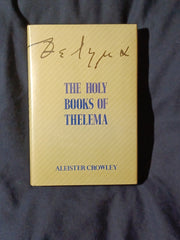Science of Survival: Simplified, Faster Dianetic Techniques by L. Ron Hubbard. "FIRST PRINTING MAY, 1951/ LIMITED FIRST EDITION"
Sold out.
Science of Survival: Simplified, Faster Dianetic Techniques by L. Ron Hubbard. The Hubbard Dianetic Foundation, Inc. Wichita, Kansas. "FIRST PRINTING MAY, 1951/ LIMITED FIRST EDITION" stated with no listing of later printings. On the page preceeding the copyright page and title page is a page stating "THIS COPY OF THE LIMITED MANUSCRIPT EDITION WAS PREPARED ESPECIALLY FOR (blank)" Underneath which there is facsimile greeting and signature of L.Ron Hubbard. 8 3/4" x 11" 548 pages plus flexible bound hardbound in slipcase with no dust jacket. Laid in is a paper awarding the status of 'Hubbard Apprentice Scientologist' to the previous owner, dated 1964, signed in facsimile by L. Ron Hubbard. SLIPCASE: Has tears, wear, missing spine and barely holds together. BOOK: Faded gilt lettering on spine is still legible. Light edge wear and light bumping to cover tips. A light scuff or two on the cover. Text appears to have been printed from hand-corrected sheets with some facsimile hand corrections. SOme wrinkling inside the front cover, possibly from publication. Light soiling on the leading edge of the pages, probably from finger handling. I find a few spots and smudges within pages but there are probably no more than a handful. There is a sample checklist laid into the back of the book that has folding on the ouitside edge because it was laid in with part outside the book. No other previous owner markings. No tears, other unpublished folds or creases to pages. Binding is tight with no looseness to pages. Not ex-library, not remaindered and not a facsimile reprint. For sale by Jon Wobber, bookseller since 1978. IH14a
"Dianetics (from Greek dia, meaning "through", and nous, meaning "mind") is a set of pseudoscientific[1] ideas and practices regarding the metaphysical relationship between the mind and body created by science fiction writer and Scientology founder L. Ron Hubbard. Dianetics is practiced by followers of Scientology and the Nation of Islam (as of 2010).[2]
Dianetics was originally conceived as a branch of psychiatry, which Hubbard would come to despise when various psychoanalysts dismissed it as unscientific. Though it is presented as a form of psychological treatment, Dianetics and its core concepts have been rejected by psychologists and other scientists from the outset and are not supported by credible evidence.[3]: 106–107
Dianetics divides the mind into three parts: the conscious "analytical mind", the subconscious "reactive mind", and the somatic mind.[4] The goal of Dianetics is to erase the content of the "reactive mind", which practitioners believe interferes with a person's ethics, awareness, happiness, and sanity. The Dianetics procedure to achieve this erasure is called "auditing".[5] In auditing, the Dianetic auditor asks a series of questions (or commands) which are intended to help a person locate and deal with painful past experiences.[6]
When Hubbard formulated Dianetics, he described it as "a mix of Western technology and Oriental philosophy".[9] Hubbard claimed that Dianetics could increase intelligence, eliminate unwanted emotions and alleviate a wide range of illnesses he believed to be psychosomatic. Among the conditions purportedly treated were arthritis, allergies, asthma, some coronary difficulties, eye trouble, ulcers, migraine headaches, sexual deviation (which for Hubbard included homosexuality), and even death.[10]
Hubbard differentiated Dianetics from Scientology, saying that Dianetics was a mental therapy science and Scientology was a religion.[22] Dianetics predates Hubbard's classification of Scientology as an "applied religious philosophy". Early in 1951, he expanded his writings to include teachings related to the soul, or "thetan".[23]" - wikipedia
"Dianetics (from Greek dia, meaning "through", and nous, meaning "mind") is a set of pseudoscientific[1] ideas and practices regarding the metaphysical relationship between the mind and body created by science fiction writer and Scientology founder L. Ron Hubbard. Dianetics is practiced by followers of Scientology and the Nation of Islam (as of 2010).[2]
Dianetics was originally conceived as a branch of psychiatry, which Hubbard would come to despise when various psychoanalysts dismissed it as unscientific. Though it is presented as a form of psychological treatment, Dianetics and its core concepts have been rejected by psychologists and other scientists from the outset and are not supported by credible evidence.[3]: 106–107
Dianetics divides the mind into three parts: the conscious "analytical mind", the subconscious "reactive mind", and the somatic mind.[4] The goal of Dianetics is to erase the content of the "reactive mind", which practitioners believe interferes with a person's ethics, awareness, happiness, and sanity. The Dianetics procedure to achieve this erasure is called "auditing".[5] In auditing, the Dianetic auditor asks a series of questions (or commands) which are intended to help a person locate and deal with painful past experiences.[6]
When Hubbard formulated Dianetics, he described it as "a mix of Western technology and Oriental philosophy".[9] Hubbard claimed that Dianetics could increase intelligence, eliminate unwanted emotions and alleviate a wide range of illnesses he believed to be psychosomatic. Among the conditions purportedly treated were arthritis, allergies, asthma, some coronary difficulties, eye trouble, ulcers, migraine headaches, sexual deviation (which for Hubbard included homosexuality), and even death.[10]
Hubbard differentiated Dianetics from Scientology, saying that Dianetics was a mental therapy science and Scientology was a religion.[22] Dianetics predates Hubbard's classification of Scientology as an "applied religious philosophy". Early in 1951, he expanded his writings to include teachings related to the soul, or "thetan".[23]" - wikipedia


















